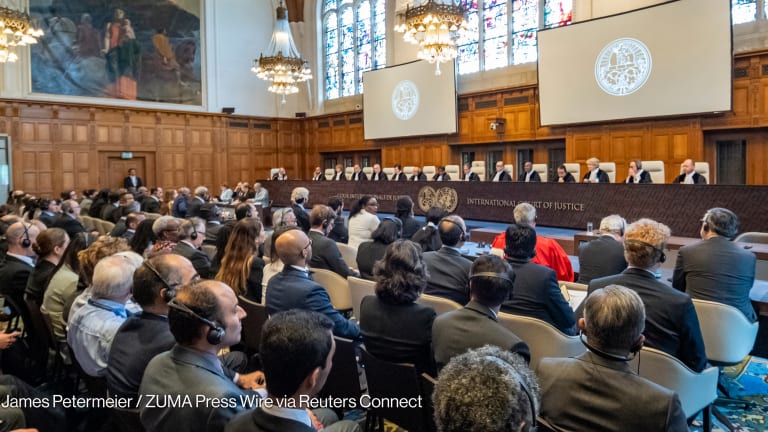
The forest ecosystems that are vital for removing carbon dioxide from the atmosphere are often the same biodiversity-rich environments that are home to a vast array of plants and animals. Losing these ecosystems is hugely damaging for both the climate and biodiversity.
However, the international negotiations that govern global efforts to combat climate change and reverse biodiversity loss have often operated in silos. Rather than seeing the two agendas as strongly aligned, the negotiations often seem to pursue separate goals.
What needs to change to hit the $100B climate finance target?
Climate experts say that new rules should be agreed upon to categorize what should count as climate finance and to govern who should pay what.
So it is significant that the Glasgow Climate Pact — the ultimate outcome of the 26th United Nations Climate Change Conference, or COP 26, which saw commitments to end deforestation from more than 100 countries and about $20 billion pledged for nature from public and private sources — directly referenced “the interlinked global crises of climate change and biodiversity loss.”
Prior to that, a biodiversity gathering in China issued the Kunming Declaration in October. While the meeting may have failed to set the targets and time frames that many had hoped for, the declaration provided an indication of what to expect from an upcoming final deal. More than 100 signatory countries committed to strengthening environmental laws, reforming financial incentives, increasing foreign financial flows, and growing the size and quality of conservation areas.
But notably, the declaration also mentioned “climate change” six times. That may not seem like much, but — similar to the references in the Glasgow Climate Pact — it marks an important recognition of the need to build stronger links between the climate and biodiversity agendas.
This need is particularly relevant in the world of “REDD+” — a U.N. abbreviation for “reducing emissions from deforestation and forest degradation,” in addition to forest restoration and protection. In fact, a criticism of a number of past REDD+ activities has been that they focused too narrowly on delivering climate outcomes, often at the cost of biodiversity and local communities. This has caused a fair bit of skepticism about the wider impact the growing REDD+ space will have.
The good news is that the past few years have seen significant strides forward. Consensus is emerging that for a REDD+ effort to be deemed a “natural climate solution,” it must also deliver co-benefits for people and nature. We saw this principle reinforced in the outcomes of COP 26, including in the decisions around Article 6 of the Paris Agreement governing the rules for cooperation between countries to enhance ambition and achieve targets for nationally determined contributions, which includes REDD+, as well as the establishment of a U.N.-backed global carbon market.
The challenge is how to turn these political sentiments into action on the ground. Historically, because of the way that activities on the ground have been designed and implemented, there was a strong focus on either conservation or climate outcomes. Adequately balancing the way we protect natural ecosystems; restoring degraded ecosystems; and managing land use for climate, biodiversity, and development benefits require viewing the situation at the landscape level.
With the proper oversight and leadership, it is possible to balance a variety of activities all of which can occur across a jurisdictional landscape, at a scale that can accommodate environmental, social and economic priorities. To do this requires working with governments that can do what only governments can do: Regulate land-use, enforce laws, promote the appropriate incentives programs, and recognize the rights and perspectives of different stakeholder groups.
While protecting and restoring the world’s remaining tropical forests is an urgent and critical solution to help keep global warming below 1.5 degrees Celsius, there are also a number of other legitimate and necessary land uses that factor into holistic landscape management plans that seek to deliver climate, biodiversity, community, and development benefits.
The political commitment shown at Kunming and Glasgow must translate into landscape-scale thinking and planning. This means that governments need to build on their recent pledges and commitments by adopting national level plans for forest protection and restoration, which are aligned with and complementary to their biodiversity and development plans.
There is significant momentum gathering from both the public and private sectors to provide incentives, in the form of results-based payments, to those tropical forest countries that are committed to this path forward.
This includes the LEAF Coalition’s — or Lowering Emissions by Accelerating Forest Finance — recent announcement that it has already mobilized $1 billion for such efforts and aims for much more in the year ahead. While these incentives are specifically designed around success in reducing or removing carbon emissions, such investments are maturing to reflect the other biodiversity, climate resilience, ecosystem, food security, and livelihoods benefits that forests provide.
While it may seem obvious that when it comes to forests, climate and biodiversity go hand in hand, there is still work to be done to ensure that these complementary goals are reflected in national commitments and plans. The signals sent from Kunming and Glasgow are important, but the true test is putting words into action.








